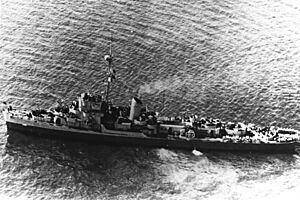USS Frederick C. Davis facts for kids
class="infobox " style="float: right; clear: right; width: 315px; border-spacing: 2px; text-align: left; font-size: 90%;"
| colspan="2" style="text-align: center; font-size: 90%; line-height: 1.5em;" | 
|}
USS Frederick C. Davis (DE-136) was a special type of warship called a destroyer escort. It was built for the United States Navy during World War II. This ship played an important role in protecting other ships. It was also the very last U.S. Navy ship lost in the Battle of the Atlantic.
Contents
| History | |
|---|---|
| Name | Frederick C. Davis |
| Namesake | Frederick Curtice Davis |
| Builder | Consolidated Steel Corporation, Orange, Texas |
| Laid down | 9 November 1942 |
| Launched | 24 January 1943 |
| Commissioned | 14 July 1943 |
| Fate | Sunk by U-546, 24 April 1945 |
| General characteristics | |
| Class and type | Edsall-class destroyer escort |
| Displacement |
|
| Length | 306 ft (93.3 m) |
| Beam | 36.58 ft (11.1 m) |
| Draft | 10.42 ft (3.2 m) full load |
| Propulsion |
|
| Speed | 21 knots (39 km/h; 24 mph) |
| Range | 9,100 nmi (16,900 km; 10,500 mi) at 12 knots (22 km/h; 14 mph) |
| Complement | 8 officers, 201 enlisted |
| Armament |
|
- Early Escort Missions
- Fighting in the Mediterranean
- Return to the Atlantic
- The Final Battle and Loss
Who Was Frederick C. Davis?
Frederick Curtice Davis was born in Rock County, Wisconsin, on October 21, 1915. He finished college at the University of Wisconsin in 1939. On July 7, he joined the United States Naval Reserve.
Becoming a Pilot
Davis began his flight training in Long Beach, California. He earned his pilot's wings and became an Ensign on September 4, 1940. This happened after he completed his training at the Naval Air Station, Pensacola, Florida.
Hero at Pearl Harbor
He was then assigned to the battleship USS Nevada. This ship operated out of Pearl Harbor, Hawaii. Davis was on board the Nevada when the Japanese attacked Pearl Harbor. He bravely ran to help load and command an anti-aircraft machine gun. Sadly, he was killed by machine gun fire from enemy planes. He was later given the Navy Cross for his courage.
The Ship's Journey: History of the USS Frederick C. Davis
The Frederick C. Davis was started on November 9, 1942. It was built by the Consolidated Steel Company in Orange, Texas. The ship was launched on January 24, 1943. Mrs. Dorothy H. Robins was its sponsor. The ship officially joined the Navy on July 14, 1943.
Early Escort Missions
The Frederick C. Davis sailed from Norfolk on October 7, 1943. Its first mission was to escort a group of ships to Algiers. It then guarded ships between North African ports and Naples. On November 6, it faced its first enemy air attack. Enemy torpedo and medium bombers damaged three ships in its group. But the Frederick C. Davis's anti-aircraft guns drove them away. On November 26, under another air attack, the ship shot down at least two enemy planes.
Fighting in the Mediterranean
The ship continued its escort duties in the western Mediterranean Sea. On December 16, 1943, it helped sink the German submarine U-73. On January 21, 1944, the ship left Naples for the Anzio landings. Its brave actions there earned it a Navy Unit Commendation.
Protecting Anzio Landings
On January 22, the Frederick C. Davis protected ships supporting the attack. It then patrolled off the besieged beachhead for six months. It only left for short breaks to resupply in Naples. The ship had special equipment to block enemy glider bombs. It fought off air attacks, protecting ships and soldiers ashore. During this tough operation, the Frederick C. Davis was hit by shellfire from shore batteries. The ship had slight damage, and only one sailor was wounded.
Return to the Atlantic
After more escort duty in the Mediterranean in June and July 1944, the Frederick C. Davis went to Corsica. This was its starting point for the attack on southern France. Here, it used its special jamming services again. It protected the headquarters ship for the operation, USS Catoctin. It stayed off the attack area on anti-submarine patrol until September 19. Then, it returned to New York Navy Yard for repairs.
The Final Battle and Loss
In early 1945, the Frederick C. Davis returned to duty in the western Atlantic. It served on coastal convoy escort and anti-submarine patrols. In mid-April, it joined a special force. This force was created to protect the Atlantic coast from German submarines. These submarines had snorkels that let them stay underwater longer.
On April 24, the Frederick C. Davis found one of these submarines, U-546. Within minutes, as the ship prepared to attack, the submarine fired a torpedo. It hit the Frederick C. Davis on its front left side. Five minutes later, the ship broke in two. Efforts to save the back part of the ship, where most survivors were, failed. The survivors left the ship and were rescued within three hours. Sadly, 115 men were lost. The attacking submarine U-546 was sunk by other U.S. Navy ships later that day. The German crew who survived were captured.
Awards and Recognition
The Frederick C. Davis received several awards for its service:
- Navy Unit Commendation
- European-African-Middle Eastern Campaign Medal with three battle stars
- American Campaign Medal with one battle star
- World War II Victory Medal
Images for kids
See also
- See List of U.S. Navy losses in World War II for other Navy ships lost in World War II.
- USS Davis for ships with a similar name.


